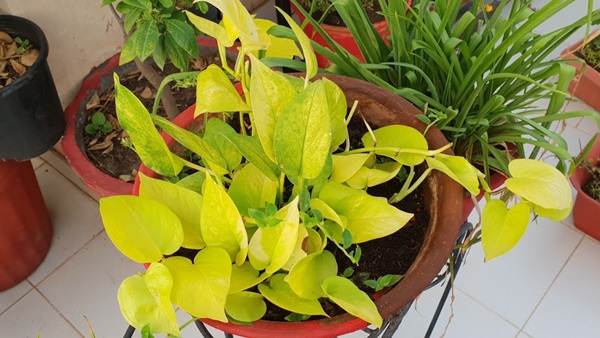Last Updated on 29 พฤศจิกายน 2022 by puechkaset
Golden pothos (Epipremnum aureum) is one of flowering and ornamental trailers that is widely planted in garden plots, pots and vases because of its plentiful and colorful leaves as well as because it can grow well in all conditions and is easy to care for.
Botanical characteristics of Golden pothos
1. Stem
This plant is a creeper or trailer with a round stem. Its mature stem is brownish green and its young stem is green. Its stem has a diameter of about 0.5-3 cm or larger, depending on its species, and consists of many segments for producing its leaves and root.
2. Leaf
Its leaves are simple leaves that are stabbed out of its stem on opposite sides. These leaves are 5-30 cm wide and 7-45 cm long, depending on its species. Leaf base is obtuse and concave while leaf apex is cuspidate and cordate. Leaf blade and margin are entire or smooth, thick and saturated with one or several colors, including light green, golden green, dark green, yellow and white.
3. Flower
Its flower is a perfect flower and is produced as a bouquet with receptacles in many colors, such as yellow, green or magenta. Its flowers are easy to fall.
Widely planted species
1. E. aureum Bunting
Its young leaves are oval while its mature leaves are cordate with levelly yellow or green stripes and sometimes with white, green or yellow stripes like those of Marble E. aureum Bunting but its leaves are larger. Its leaves and stem are larger than all other species. Leaf surface is undulate and the height of its mature stem can be over 15 meters. It is commonly grown in plots or attached to a big tree because of its very long stem.

2. E. aureum Bunting cv. Marble Queen
Its leaves are cordate with green and white marble-like strips. Its petiole may be white with green stripes along its length. Its stem is medium size and shorter than E. aureum Bunting. It can grow over 5 meters tall and is commonly planted as an ornamental plant in vases or pots.

3. E. aureum Bunting cv. Tricolor
It is a species with the smallest stem but its size is similar to Marble Queen. Its mature stem can grow over 3 meters tall. Its leaves are light green, yellowish green or yellow and its petioles are green, and yellow stripes may sometimes be found. It is popularly grown as an ornamental plant in vases or in pots.

Benefits of Golden pothos (Epipremnum aureum)
This plant is an ornamental plant that is commonly planted in garden plots, pots and vases because of its large, plentiful, colorful and beautiful leaves. It is easy to grow and care for in all conditions. Its growing can be classified by species as follows:
1. E. aureum Bunting is commonly planted in garden plots and is mostly attached on poles or trees because of its large and very tall stem, its large and thick leaves, and especially its deep root, which is not suitable for growing in pots or vases.
2. E. aureum Bunting cv. Marble Queen has medium size and is popularly planted in garden plots and pots while growing in the vases may be found for small ones.
3. E. aureum Bunting cv. Tricolor is commonly planted in pots, vases and garden plots because of its small stem and because it is strong and can grow well with less light, such as within a hall and office, including in plots with large and tall trees and less light.
Growing Golden pothos
This plant can be grown by seedling and cutting. However, since it takes several years to produce its flowers and seeds, it is mostly propagated by branch or stem cutting because such cutting can be rapidly successful and its branches are less likely to die. This cutting can be done in seedling media or in water.
Cutting in the soil is suitable for all species while cutting in the water is only for E. aureum Bunting cv. Marble Queen and E. aureum Bunting cv. Tricolor because of their small leaves and stems that can produce a new root rapidly and their stems do not rot easily.
Nowadays, this plant can be grown by three ways as follows:
1. Growing Golden pothos in a garden plot
Growing in a garden plot is an ideal growing technique for all species. E. aureum Bunting is only suitable for being planted in garden plots by attaching it on a large tree or wooden or concrete pole while other two species are planted at the bottom so that they go along the ground or attached on a low wooden stick.
Growing in a garden plot should be done under a large tree so that its stem can go upwards. More importantly, this large tree is useful for sun protection and giving moisture to this plant because this plant does not like strong sunlight and heat.
Care after growing should be taken by arranging its vine or stem apex on the tree and using a loose strap to help it climb faster.
Fertilization may be occasionally applied because it does not need many minerals. It is sufficient to use farm yard manure or compost, while watering should be regularly done for at least 5-7 days once.
2. Growing Golden pothos in a pot
Growing in a pot is ideal for E. aureum Bunting cv. Marble Queen and E. aureum Bunting cv. Tricolor and can be done in both a hanging pot and a pot on the ground. This growing technique uses soil mixed with organic materials, such as rice husks, coco-coir dusts, leaf scraps or dung, at a ratio of 1:1 or 2:1.
Growing in a pot on the ground needs to stab a wooden stick at the center of such pot covered with coco-coir dusts for its root to adhere to. Watering is done from the top of such wooden stick to the pot’s edge. For growing in a hanging pot, the stem of this plant is attached on the stretched wires; however, if its stem is very large, it must be trimmed to the appropriate size, but it is generally preferred to allow climbing downwards. It should be regularly watered at least 3 days once.
3. Growing Golden pothos in a vase
Growing in a vase or other applied materials, such as glass or bottle, uses water instead of soil and may use water or chemical fertilizer-dissolved water only. This growing technique is commonly used for E. aureum Bunting cv. Marble Queen and E. aureum Bunting cv. Tricolor.
If only water is used, such water should be well or underground water that is clear and not dirty or spoiled because this source of water has better minerals that help to grow than rain or tap water.
Chemical fertilizer-dissolved water or growing in before putting in chemical fertilizers is a better way of adding minerals to the plant than using only water. The formula of these fertilizers is 16-8-8 and its ratio to water is 10-20 tablets per one liter of water. These fertilizers should be provided every 2-3 months, depending on the stem size of this plant. In addition, water should be exchanged every one or two times of fertilization because these fertilizers increase the acidity of water that may cause this plant to wither and die especially when excessive fertilizers are used.
Care must be taken to prevent water dryness because this plant likes and needs water. However, it also needs dim sunlight that may come from sun or neon light, but it must be not overheating because its leaves may be burnt. Therefore, when it is very hot, water should be provided or sprayed onto its leaves avoid withering.



